



|

|

|
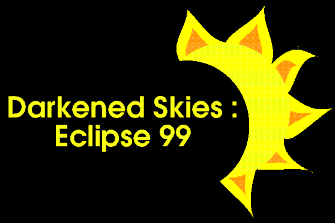
The Sun, our nearest star, provides all the light and heat needed for life on Earth. It is no wonder that ancient civilisations worshipped it as a god. On 11th August 1999 a total eclipse of the Sun will be visible from parts of the UK. It will provide a spectacular display, but why is it so interesting?
Sun Block `99 is a World Wide Web based educational project which seeks to answer this question by presenting the very latest solar research. Through a range of multi-media activities, young scientists from all over the UK (our Solar Guides) take us on a journey of discovery to one of the most fascinating places in our solar system.

These pictures show what are called BAILY'S BEADS at the end of a total eclipse of the Sun. Baily's Beads are actually caused by rays of light from the Sun's surface, photosphere, shining along crevices on the edge of the Moon.
During a total eclipse, the moon completely blocks out the Sun. What you can see is the corona, the Sun's crown, or outer atmosphere. It's very difficult to see the corona normally because the visible light from the solar surface is a million times brighter than the light from the corona.
Although the solar surface, photosphere, is at a temperature of 6000 degrees, the corona is very hot - the temperature is almost 2,000,000 C! This problem has puzzled solar physicists for more than 50 years and there are lots of different theories as to why this should be so. The corona could be heated by waves travelling up from the photosphere. We know that the magnetic field plays an important role, so magnetic re-connection could transfer magnetic energy into thermal (heat) energy. If you look at the Sun in X-ray emission you see only the plasma (ionised gas) at above one million degrees. You can clearly see the structure of the magnetic field. The Sun generally has a dipole magnetic field (like a bar magnet). The field lines are open in the polar regions and the corona flows out in the solar wind. In the equatorial region, the magnetic field is closed and we see bright hot loops of trapped plasma, called active regions. These are where the sunspots are seen in visible light.
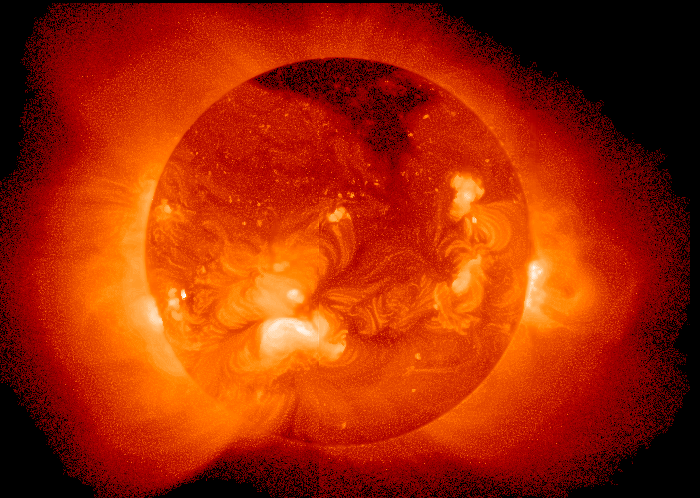
X-ray image from the SXT instrument on YOHKOH, a Japanese satellite (ISAS/NASA/UK).
As the Moon travels around the Earth, it sometimes passes between the Earth and the Sun causing a shadow of the Moon to wind its way across the surface of the Earth. To see a total solar eclipse, you have to be in just the right place on the Earth. When you look up (with a special filter!) in the sky at the Sun and the Moon, you notice a strange coincidence - both look the same size in the sky. They are not really the same size. The Sun's diameter is 400 times larger than the Moon's diameter, but the Sun is also 400 times further away from the Earth so to us it looks the same size as the Moon! It is an amazing coincidence that the Moon is exactly the right size and distance from us to just block out all the light from the solar surface.
When you are standing on the Earth, you must be in a very special place to see the Moon cover the entire face of the Sun. If you move a little to the North, the Sun would peek out over the top of the Moon; a little to the South, and the Sun shines past the southern limb of the Moon. The match is so good that the "path of totality" is never more than 268 km wide, and is usually less. This means that very few people have seen a total eclipse because the shadow only covers a very small area on the Earth.

This picture shows how the Sun, Moon and Earth line up during a total Solar eclipse. From anywhere in the penumbra, you will see (remember - with a special filter!) some part of the Sun shining from behind the Moon while people within the umbra will witness a total eclipse.

This sketch map shows whether the eclipse will pass your way. Of course, to really experience this event you need to be in the path of totality, but not everyone in the UK can fit into Cornwall, so some of you will have to watch the full effect of the eclipse on TV.
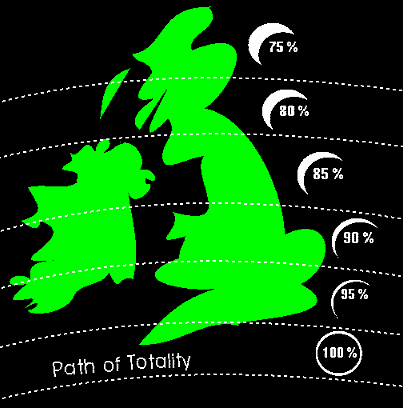
During the first moments of the eclipse, the Moon begins to blockout the Sun's disc. It looks as if a 'bite' has been taken from the edge of the Sun. It is an awesome sight.
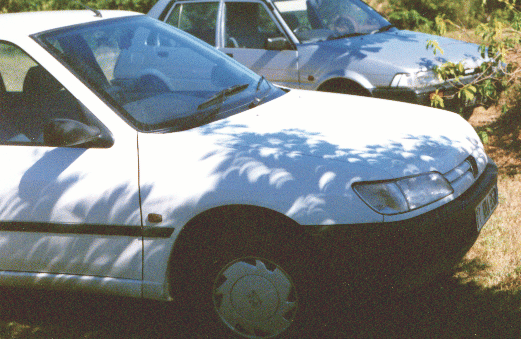
This photo was taken during the 1998 eclipse in Guadeloupe. You can see many images of the crescent Sun. The gaps in the tree's foliage act like tiny pinhole cameras. Each one focusses an image of the Sun onto the car.
After this, more and more of the Sun's photosphere (the visible surface of the Sun) is 'eaten' away until the total eclipse. Then the Moon completely blocks out the Sun's surface. During 'totality' the Sun's corona can be seen really clearly. You can look at the Sun without a filter during totality. The total eclipse then only lasts for 2 or 3 minutes.
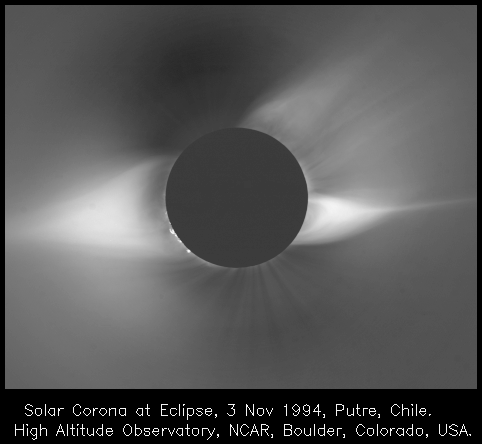
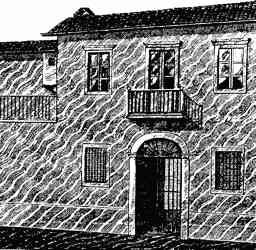
|
Another really interesting effect which occurs just before an eclipse is shadow bands. These are parallel light and dark bands moving across the ground. They are caused by air moving in our atmosphere. You can see them best on an open floor or wall. They give the world around a really eerie appearance. |
|
|

Above is an image, or rather a montage of two images from SOHO. The inner image of the Sun is taken by EIT in ultraviolet light, which shows plasma at around one million degrees. The outer image is from UVCS and shows the corona.
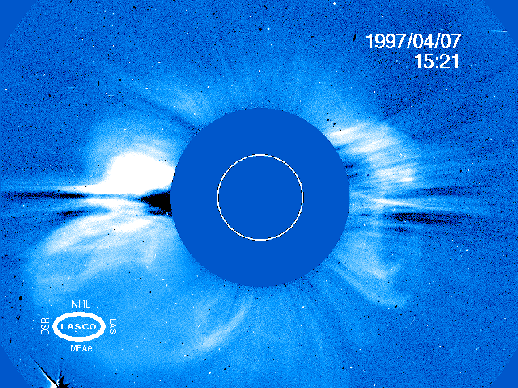
An image taken by the LASCO coronagraph on SOHO, which simulates a total eclipse of the Sun. The white circle shows where the Sun's disk should be (if it were not blocked out). Plasma, called a coronal mass ejection, is shot out into the solar wind and can impact on the terrestial environment, causing problems with satellites, radio blackouts and disruption to electricity supplies. This is what we call space weather.
This project is produced by a team from the Rutherford Appleton Laboratory and the Universities of St Andrews and Cambridge, together with educational consultants. The production of the web pages has, in part, been sponsored by PPARC and the Millennium Mathematics Project.
To explore Sun Block '99, link through to: